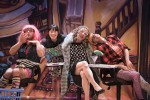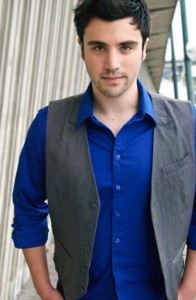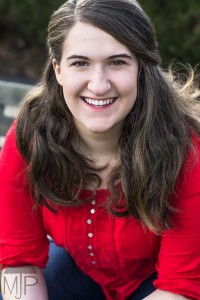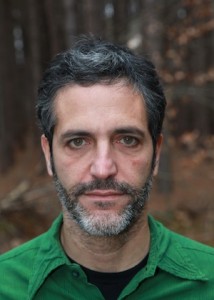Leanna Brodie plays spinster Ms. Fitt (and the boy Jerry) in Blackbird Theatre’s Canadian première of Samuel Beckett’s All That Fall, at the Cultch until Jan. 24. (photo from Leanna Brodie)
She is an actor, playwright, librettist, feminist, social activist – bilingual on top of all that – and just landed a coveted role in Blackbird Theatre’s Canadian première of Nobel laureate Samuel Beckett’s All That Fall, running at the Cultch until Jan. 24. Leanna Brodie is one talented person.
On a rainy Saturday afternoon, she sat down with the JI to talk shop during a rehearsal break.
Born and raised in rural Ontario, Brodie said, “I am a bit of an odd duck as far as Judaism goes, my father was Jewish but my mother was not. She came from rural Ontario. My upbringing was secular but I have a Jewish soul. My family always communicated through jokes, something that I see as being steeped in Jewish culture. I also see curiosity as part of my Jewish heritage, which is a good thing because you understand thought processes better, which I think I bring to my work.”
She went to drama school at the University of Guelph and was able to support herself as an actor in her first years at the job. As she got older, however, there were fewer roles available and she reconsidered her future. She had never before pictured herself as a playwright. “I was chatting with a bunch of girlfriends one day and we were complaining that there were no acting parts for women in their 30s and 40s. So, I thought, I am not going to sit around, wait by the phone until I get called for a part, I am going to write something for women. I finished my first play in five weeks. Since that time, I have written over 50 roles for women.”
Brodie now has three successful plays and one opera to her credit. Her topics are often motivated by contemporary social issues – homophobia, fundamentalism, the environment, to name a few. In The Book of Esther, she explores some of these issues through the eyes of a young country girl coming to the big city. “I think that play was the most autobiographical for me even though there is a little bit of you in everything you write. Here I was coming from rural Ontario to Toronto and I had a phobia of subways.”
She actually took on one of the roles in The Book of Esther. “That was like an out-of-body experience for me. Once you are in a scene, then it is like any other gig and you do your bit and walk on and off, but, when not in a scene, I could not resist the temptation to be in the wings and listen to the audience reaction to my play.”
As an actor, she has appeared across Canada and, in one of her first jobs in Vancouver – a role in Pi Theatre’s Terminus – she was nominated for a Jessie award.
Her writing is done in her down time from being on stage. “Acting is all-consuming, all your antennae are out for anything that will help your performance, any creative juice. During rehearsal, you are entirely focused. You can act in more than one show at a time but you cannot write at the same time.”
Brodie is on a temporary hiatus from writing as she hones her thespian skills with All That Fall, a bucolic play – a perverse combination of comedy and tragedy – that Beckett wrote for radio audiences. He wanted the words to come “out of the dark,” to be an auditory experience, not a visual one. He resisted attempts to have the play transformed into a stage production (even Sir Laurence Olivier and Ingmar Bergman could not get his permission to produce the play on stage). It was only recently that his estate, at the urging of British director Trevor Nunn, allowed a London production, which played to critical acclaim and ultimately crossed the pond to Broadway. Now, Canadian audiences are in for a treat from this Irish wordsmith.
The story is as follows. A 70ish, garrulous, overweight Mrs. Rooney trudges the Irish country roads to meet her blind husband’s train at the station. On the way, she encounters an assortment of quirky characters who are using various modes of transportation – a cart, a bicycle, an automobile – to go about their daily business. Against this backdrop, they pass the time exchanging droll comments that border on the absurd, reflective of Beckett’s existential angst. The train is late. On the walk back home, as the old couple verbally spar, the audience begins to sense that there is a mystery lurking behind the dialogue.
This is the first Beckett work that has a woman as the main character. That, along with the radio format, drew Brodie to the play. “Beckett is on every actor’s bucket list,” she said. “There are so very few opportunities in his repertoire to land a female role.”
Brodie actually plays two characters: a religious spinster, Miss Fitt, and a young boy, Jerry. “This play is fresh and interesting and full of Irish humor. Usually with Beckett you have those unforgettable stark images, like two trashcans or a dead tree. Here, the dynamics are different. There is more lushness than in any [other] Beckett play because of the demands of radio, and there is more of a sense of a real place. You get the impression that Beckett sees the traditional Irish life dying around him and he uses very black humor to protect himself from this perceived dark abyss.”
She added, “Unlike Beckett’s iconic Waiting for Godot, where they say nothing happens twice, in All That Fall, something is always happening and what the person, the protagonist, is waiting for actually appears.”
“Part of the allure of the format is the fact that the audience becomes the collaborator with you and creates the world, it becomes a cooperative venture between the actors and the audience.”
Brodie has the radio bug in her blood. Her father had a morning show called Breakfast with Brodie and was a voice artist. She has worked in radio drama for the CBC. “I was wistful about losing the radio show format in Canada and was atoning for the fact that I feel like I killed radio drama in this country, as one show I worked on, The Seeds of Our Destruction, was the last stand-alone radio show CBC aired. So, I really wanted to do this show to sort of redeem myself. Part of the allure of the format is the fact that the audience becomes the collaborator with you and creates the world, it becomes a cooperative venture between the actors and the audience.”
About why Vancouver audiences should see this play, Brodie said, “Beckett is arguably the greatest writer of the 20th century and this play is done from an aspect never seen or heard before and who knows if we will ever have this chance again. Also, you get to see an extremely talented professional cast [William Samples, Lee Van Paassen, Adam Henderson and Gerard Plunkett], who get it right.”
This writer had the good fortune to sit in on the first read-through of the play. Director Duncan Fraser put the five actors through their paces, scripts in hand at separate microphones on the stage. The actors also are responsible for all of the sound effects, the rattling wind, a bothersome wasp, the opening and closing of doors, the crunching of feet on gravelly roads, the whistle of the train. Just watching the props used to create the noises was an experience. However, the real experience is being immersed in this lost world of radio drama where for 75 uninterrupted minutes you can let your imagination soar.
For tickets, visit thecultch.com or call 604-251-1363.
Tova Kornfeld is a Vancouver freelance writer and lawyer.












